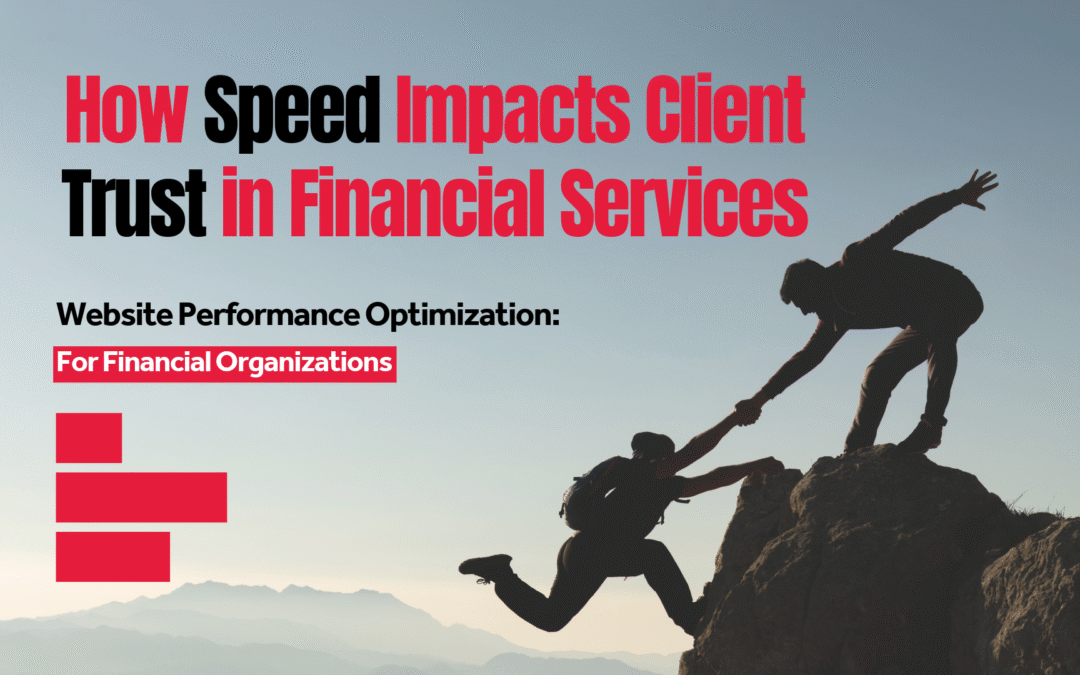“First impressions stick – especially when your money’s on the line. And nothing says ‘don’t trust me’ like a spinning wheel on a financial website.”
I. The Trust-Speed Connection
Let’s get this out of the way: 47% of users expect your web page to load in two seconds or less. That’s not my opinion – that’s hard research [Akamai Study]. And when you’re in financial services, the stakes aren’t just lost sales – they’re lost trust, lost assets, and maybe even the client’s retirement dreams.
Ever clicked a link to your bank or advisor and watched the page stutter, freeze, or – God forbid – timeout? Did you feel like your money was in safe hands, or did a tiny voice in your head scream, “Run!” That’s the reality we’re living in. Clients don’t just judge your professionalism by your handshake anymore – they judge it by your load times.
In this guide, I’ll break down:
- The psychology behind why speed equals trust,
- What “good” performance looks like for financial websites,
- How to optimize (without blowing up your budget or breaking your compliance setup),
- And how to keep your site tuned for the long haul.
This isn’t theory. This is how you actually build – and keep – trust, one millisecond at a time.
II. The Psychology of Website Speed in Financial Services
First Impressions: Blink and You’ve Lost Them
Here’s a gut punch: It takes just 50 milliseconds for users to form a first impression of your website [Google Research]. If your homepage or client portal stutters, you’re not just losing a sale – you’re losing the chance to ever be trusted again.
What’s wild is how deeply speed is tied to credibility. Clients equate a fast site with:
- Professionalism: “If they care about their site, maybe they care about my money.”
- Security: Ironically, people trust quick sites more – even though speed and security are sometimes in tension.
- Technical Competence: “If they can’t keep a website running, how are they managing my investments?”
The (Painful) Numbers: What Slow Sites Really Cost
Let’s get surgical:
- Bounce rates skyrocket: A site that loads in 5 seconds has a 38% higher bounce rate than one that loads in 2 seconds [Google/SOASTA Study].
- Form abandonment: Every second of delay on a form increases abandonment rates by up to 7% [Akamai Study].
- Mobile users are even less patient: 53% will bail if your site takes more than 3 seconds to load on mobile.
Ever had a prospective client fill out half your “Schedule a Consultation” form and then ghost? Odds are, they didn’t hate your questions – they just got tired of waiting.
The Competitive Reality
Here’s the not-so-secret truth: Clients are always comparison shopping, even if they say they’re not. If your competitor’s site loads faster, you look like you’re running a lemonade stand on dial-up. (Don’t even get me started on how younger clients, raised on Venmo and Robinhood, expect instant everything.)
And here’s a painful kicker: Slow sites look less secure. In an industry where trust is currency, that’s a dealbreaker.
Key Takeaway:
Speed isn’t a “nice to have.” It’s the digital handshake. If you fumble it, you might never get another shot.
III. Financial Services Website Performance Benchmarks
What’s “Good Enough” in 2025?
Let’s talk numbers:
- Homepages/Landing Pages: Aim for <2 seconds load time.
- Client Portals: Under 1.5 seconds for login screens; sub-2 seconds for dashboards.
- Document Downloads: PDF statements should appear in <3 seconds.
Mobile’s a different beast: 70% of financial site visits now start on mobile [Statista], and expectations are just as high.
Geography matters too. Clients in urban US expect lightning speed, but if you serve rural or international clients, test performance from their locations.
The Portal Test: Where Trust is Won or Lost
If you have a login page, it must fly. The “dead zone” is the 2-4 second window where users start to wonder if their password’s wrong, or worse – if the site’s been hacked.
Real-time data? Glitchy dashboards or delayed transaction updates are trust killers. Your data doesn’t just need to be accurate – it needs to feel immediate.
How to Benchmark (The Real Way)
Don’t just run a single test and call it a day.
- Test multiple times, at different times of day.
- Use tools like WebPageTest and Google PageSpeed Insights.
- Track metrics by page type (homepage, portal, docs, blog).
Compare against direct competitors, not just industry averages. If you’re at 2.5 seconds and the local competitor is at 1.2, guess who just won a new client?
Pro Tip:
Document your benchmarks. Use them in board meetings. Make performance a KPI, not an afterthought.
IV. Technical Optimization Strategies for Financial Services
Core Web Vitals: The Big Three
You’ll hear Google harp on these until you dream in acronyms:
- Largest Contentful Paint (LCP):
- Goal: Under 2.5 seconds.
- Fixes: Optimize hero images, use lazy loading, minimize render-blocking scripts.
- First Input Delay (FID):
- Goal: Under 100 milliseconds.
- Fixes: Cut third-party scripts, streamline JavaScript, defer non-critical code.
- Cumulative Layout Shift (CLS):
- Goal: Less than 0.1.
- Fixes: Set explicit sizes for images/ads, avoid inserting content above existing content.
If these sound abstract, don’t panic. Google’s Web Vitals guide is your friend – and there are plugins to monitor these automatically.
Security vs. Speed: Finding the Balance
SSL certificates are non-negotiable, but bad implementation can slow things down.
- Use HTTP/2 or HTTP/3 for faster encrypted connections.
- Avoid heavy security plugins that check every page on every load – opt for server-level firewalls or managed WAFs.
Encryption overhead is real, but minor if configured right. If your “security stack” is dragging you down, rethink it. Security that scares away users isn’t protecting anyone.
Content Optimization: The “Easy Wins”
- Image Compression: Use TinyPNG or ImageOptim to keep images crisp but small.
- Minify JavaScript/CSS: Tools like UglifyJS and cssnano cut file size.
- Database Tuning: Index fields, prune junk, and cache heavy queries.
I once shaved a full second off a client portal load time just by compressing PDF templates and cutting a bloated script from the homepage.
Infrastructure: The Backbone
- CDN (Content Delivery Network): Services like Cloudflare or Akamai put your site closer to your users. This isn’t optional for national/international firms.
- Server Response: Switch to a managed VPS or cloud host with SSD storage. Shared hosting is for hobbyists.
- Caching: Use server-side caching (Varnish, Redis) and browser caching for static assets.
Key Takeaway:
Optimization is a process, not a project. The “big rocks” (images, scripts, hosting) usually yield the biggest wins – but only if you keep them on your radar.
V. Mobile Performance Optimization for Financial Services
Mobile-First Isn’t Just a Buzzword
By 2025, nearly three-quarters of the world will use smartphones to access the internet [Statista]. If your site chokes on mobile, you’re invisible.
- Touch-Friendly Design: Buttons should be big, tap targets clear. No tiny “submit” links.
- Simplified Navigation: Hamburger menus, sticky nav bars, and search that actually works.
- Optimized Forms: Autofill, minimal fields, and no crazy dropdowns.
Mobile Metrics That Matter
- Test on 3G/4G networks (not just your office WiFi).
- Use Lighthouse to track Mobile Core Web Vitals.
- Consider a Progressive Web App (PWA) approach for a more “app-like” experience.
Portals on the Go
- Streamline login: Biometric options (FaceID, fingerprint) if possible.
- Document viewing: PDFs need to be readable and zoomable, not just “downloadable.”
- Communication tools: Chat, notifications, and contact forms must be instant and reliable.
If you’re still making clients pinch-zoom and squint, you’re bleeding credibility – and probably getting roasted in private Facebook groups.
VI. Monitoring and Continuous Improvement
Don’t “Set and Forget” Your Site
- Real User Monitoring: Tools like New Relic or Datadog show what actual clients experience.
- Synthetic Testing: Schedule regular speed tests with Pingdom or Uptrends.
- Core Web Vitals Tracking: Set up automated reports. If your scores dip, trigger a review.
Make Optimization a Habit
- Monthly Audits: Fix issues before clients complain.
- Quarterly Reviews: Review your stack for new performance tools and deprecate old plugins.
- Annual Assessments: Look at the big picture – does your platform still fit, or is it time to re-platform?
Let Clients Tell You When You Suck
- User Surveys: Simple “How was your experience?” popups or follow-ups.
- Complaint Tracking: Log speed-related complaints; treat them like security alerts.
- Satisfaction Correlation: Tie NPS or client satisfaction to site performance metrics.
Key Takeaway:
Clients won’t always tell you what’s wrong, but their bounce rates and survey answers will.
Content Assets
Website Speed Testing Checklist
- Homepage, portal, and document page speeds under 2 seconds?
- Mobile and desktop performance tested?
- CDN and caching enabled?
- Images compressed and scripts minified?
- Security plugins not tanking load times?
- Regular speed tests scheduled?
Performance Optimization Roadmap
- Benchmark: Where are you slowest?
- Quick Wins: Compress images, minify code, enable caching.
- Infrastructure: Upgrade hosting, add CDN.
- Ongoing Monitoring: Set up alerts for dips in performance.
- Client Feedback: Regularly survey and review complaints.
Mobile Optimization Guide
- Test every page on real devices (not just emulators).
- Shrink forms, enlarge buttons.
- Prioritize fast login and document access.
- Kill any popups or scripts that slow mobile loads.
Client Feedback Survey Template
How satisfied are you with the speed of our website?
❏ Very Satisfied
❏ Satisfied
❏ Neutral
❏ Dissatisfied
❏ Very Dissatisfied
What, if anything, frustrated you about your experience today?
[Text Box]
Did you access our site on mobile, desktop, or both?
What would you like to see improved?
Recap: What Actually Builds Trust (and What Doesn’t)
Top Lessons:
- Speed = Trust in financial services. Don’t let anyone tell you otherwise.
- First impressions are brutal. Users judge your competence in 50ms.
- Optimize Core Web Vitals – they’re more than just SEO fluff.
- Balance security with speed – overdoing either can kill trust.
- Mobile is everything. If you’re not fast there, you’re nowhere.
- Continuous improvement beats one-time sprints. Monitor, iterate, repeat.
- Listen to clients. If they’re complaining (or just leaving), it’s probably your fault.
Action Steps:
- Run a speed audit today. Fix the top three slowest elements.
- Set up monthly monitoring and client feedback loops.
- Commit to never letting your website be the weakest link in your client’s trust chain.
Have you been burned by slow site speed – or saved a client relationship with a quick fix? Hit reply, challenge my advice, or ask a question. If you want a free audit or some no-BS feedback, just connect on LinkedIn.
Let’s build something clients can trust.

Author: Jason Long
Jason is a serial problem solver and entrepreneur with 20+ years of experience in business building.
Jason’s ventures range from agriculture to healthcare with a focus on web-based technology. He has extensive experience in software development and has operated as a developer, UX designer, graphic designer, project manager, director, executive coach, and CEO.
Linkedin
Personal Website
